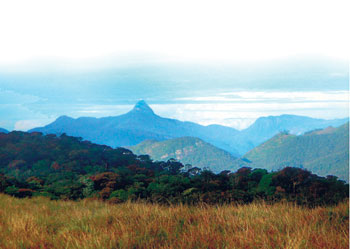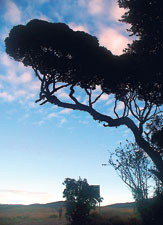“I have drunk to the full the sweet fragrance of dudhli flowers on moon-lit nights and, each time, I have felt that while I was in the city I had not known that moonlight could be so exquisite, that it could evoke such fear and detachment. I will not attempt to describe those moonlit nights; one may not experience them merely by hearing or reading of them. Beauty of this sort comes alive only under the wide-open skies, in silence and loneliness, with the undulating forests stretching as far as the horizon.”
 |
| SriPada Mountain seen during day time from the Hortan Plains |
Ever since I read the translation of Indian writer Bibhutibushan Banyopadhyay’s novel Aranyak (in the forest), it had been my obsession to experience a forest lit by moonlight. The undulating misty plains stretching as far as the horizon and the silent moonlit night on Christmas day made me think that perhaps God had recreated the exact scene described in ‘Aranyak’ on the mystical Horton Plains. Yes, the author Bibhutibushan was right... The serenity couldn’t simply be expressed in words!
I made this wonderful night journey with a group of young zoologists who had received permission (rarely granted) to do a night study on Horton Plains. December is the coldest month and the worst period to visit Horton Plains even during the day. Perhaps, we were a bit ‘crazy’ to step out in the freezing cold at night.
It was around 9 p.m. when we left our lodging at Mahaeliya, well padded with layers of warm clothes. There was a slight drizzle. The thick mist had blocked our view, but only one torch was allowed. We were under strict orders not to utter a word unnecessarily to avoid disturbing the silence of the plain. The gusty wind that swept across the grasslands doubled the freezing cold.
We had only gone a few yards from the Mahaeliya Dormitory when Pubudu’s torch caught two glowing eyes that were shining like a pair of diamonds. It was a male sambhur that had come very close to the road to graze. Next to it were three females. “During day time, sambhur prefer to stay in the forest patches and come to the plains at night time,” explained Pubudu Weeratne, president of the Young Zoologists Association (YZA), who is also the senior instructor of the Mammals group. It did not seem disturbed by our presence and continued to graze.
At night time, sambhur can see an approaching leopard from a distance when in the plains. Earlier in the day, we had seen a decomposing sambhur carcass near the Mahaeliya circuit bungalow. According to the caretaker, it was a pregnant sambhur that had fallen victim to a hungry leopard – the apex predator of Horton Plains, who become active at night time. Leopards are not easy to observe in the natural environment in the hill country, hence considered elusive.
Pubudu suddenly jumped into a gully. He had spotted pug marks. “This leopard must be big and the pug mark is not too old,” he said. It was deeply embedded in the soil. As we went on, we spotted many herds of grazing sambhur and more pug marks hinting at the constant drama of predator and prey.
The next day, the camera traps set by the Young Zoologists captured images of a well-grown leopard. It is believed Horton Plains is home to more than 20 leopards, but it is really hard to study them.
The clouds and the mist were now sweeping away. The moon was peeping out above the pygmy forest adding a ghostly look to the environment. I lifted the ear flaps of my winter cap to listen to the sounds of the night. The occasional alarm call of sambhur could be heard, perhaps warning the others about the unexpected intruders in the plain. Even frogs were silent on the grassland, perhaps they also found it too cold.
“Look at the left,” said someone and we did to see a pattern like a bunch of fireflies in the sky. It was Sri Pada. The mist had now gone and the pilgrim path toward the sacred peak, all lit up could be clearly seen.
I heard a faint sound in the sky and saw the lights of a moving airplane. It was moving quite fast and soon had taken a turn and was heading toward the lights of Sri Pada. I remembered the DC-10 airplane tragedy that killed all 192 passengers some 30 years ago hitting the Saptha Kanya cliff located in the Sri Pada mountain range. “There is a landing path going across the Sri Pada area,” explained Dimuthu Wickremasinghe, a telecommunication engineer among the Young Zoologists who had sacrificed the night walk to cook dinner.
It was around 11 p.m. at the time we reached the Arrenga pool after walking about 3 km in the dark. This is a famous location among birders for spotting the secretive Sri Lanka Whistling Thrush known as Arrenga. But we were greeted only by few ‘croaks’ and Thompson and Thompson – the twin zoologists who were both fascinated with amphibians managed to find a few frogs hidden under the plants. We also saw a sleeping Rhinoceros Horned Lizard, but did not disturb it.
It was time to turn back. Now the mist had gone, revealing the inforgettable sight of thousands of stars on the wide open sky.
The cold night walk had meanwhile made us ravenous. We returned to the camp around midnight for a Christmas supper of warm samba rice together with salmon and dhal. |



